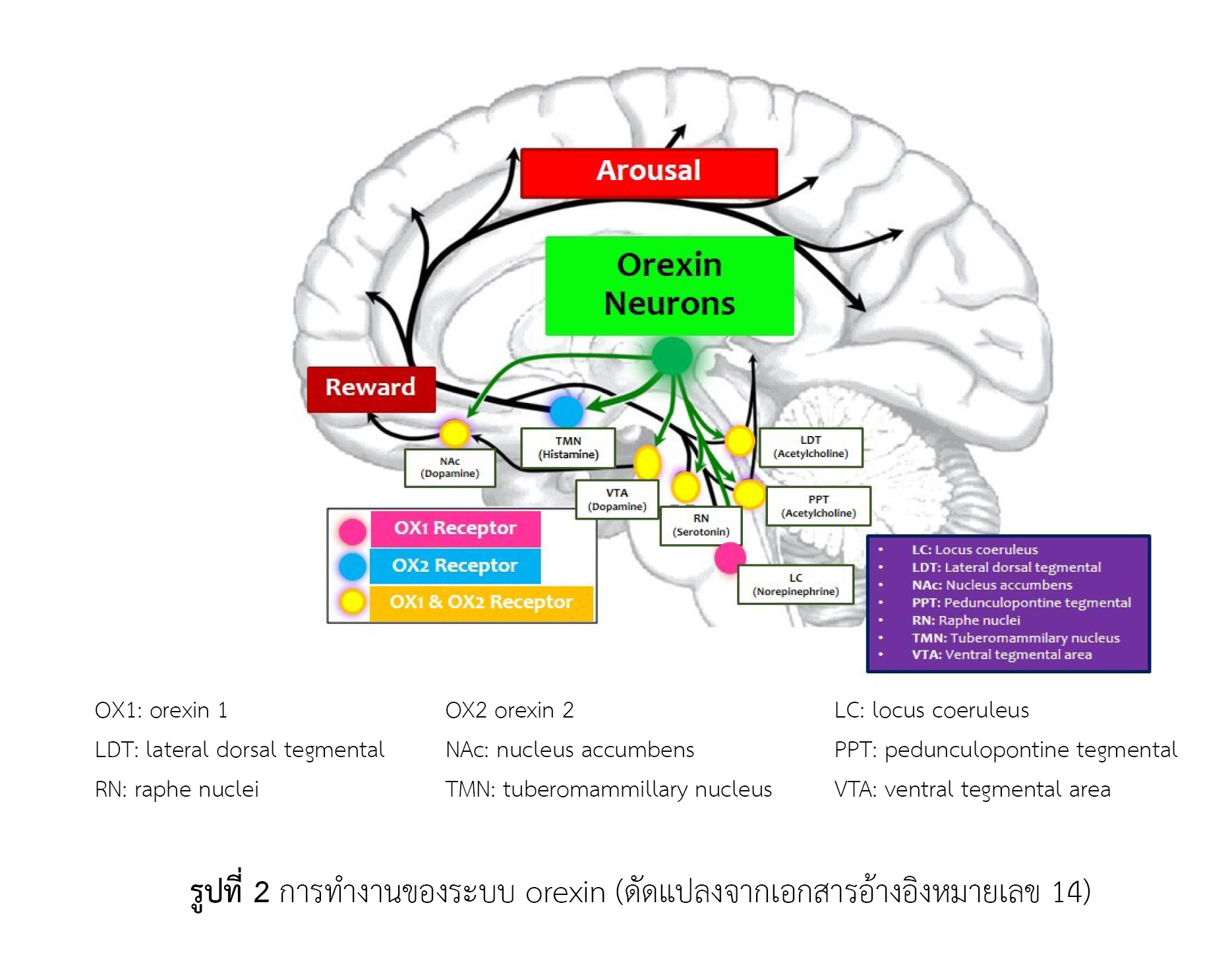Dual Orexin Receptor Antagonists สำหรับรักษาโรคนอนไม่หลับ: ทบทวนข้อมูลยา Suvorexant และ Lemborexant
คำสำคัญ:
โรคนอนไม่หลับ, dual orexin receptor antagonists, suvorexant, lemborexantบทคัดย่อ
โรคนอนไม่หลับถือเป็นปัญหาที่สำคัญในระบบสุขภาพ เนื่องจากส่งผลกระทบต่อคุณภาพชีวิต การทำงาน รวมทั้งเพิ่มความเสี่ยงในการเกิดโรคต่าง ๆ ตามมา ยาในกลุ่ม benzodiazepines และ non-benzodiazepines จัดเป็นกลุ่มยาที่นำมาใช้รักษาโรคนอนไม่หลับอย่างแพร่หลาย แต่อย่างไรก็ตามพบปัญหาในด้านความปลอดภัยในการใช้ระยะยาว โดยเฉพาะภาวะพึ่งพายา ภาวะทำพฤติกรรมต่าง ๆ ในขณะหลับ รวมทั้งรบกวนความจำและการเรียนรู้ ยาที่ปิดกั้นตัวรับ orexin แบบ dual เป็นกลุ่มยาใหม่ที่นำมาใช้รักษาโรคนอนไม่หลับ โดยยาจะเหนี่ยวนำการนอนหลับและลดการตื่นตัว จากการแย่งจับตัวรับ orexin 1 และ 2 กับสารสื่อประสาท orexin ยาในกลุ่ม dual orexin receptor antagonists ได้แก่ suvorexant และ lemborexant ได้รับการอนุมัติจากองค์การอาหารและยาของประเทศสหรัฐอเมริกาในการรักษาโรคนอนไม่หลับ โดยพบรายงานประสิทธิภาพในการลดระยะเวลาในการเข้านอนและเพิ่มระยะเวลาในการนอนหลับโดยรวม อีกทั้งยังมีประสิทธิภาพและความปลอดภัยเมื่อใช้ติดต่อกันเป็นระยะเวลานาน ไม่ทำให้เกิดภาวะพึ่งพายา ภาวะถอนยา รวมถึงการทำพฤติกรรมต่าง ๆ ในขณะหลับ สำหรับประสิทธิภาพและความปลอดภัยมีแนวโน้มสัมพันธ์กับขนาดยา โดยพบว่า lemborexant มีแนวโน้มมีประสิทธิภาพที่เหนือกว่าและมีผลข้างเคียงที่มากกว่าเมื่อเปรียบเทียบกับ suvorexant โดยสรุป suvorexant และ lemborexant ถือเป็นทางเลือกในการรักษาโรคนอนไม่หลับโดยเฉพาะผู้ที่ไม่สามารถทนต่อยาหรือมีข้อห้ามใช้จากยากลุ่มอื่น ๆ และยังต้องมีการศึกษาเพิ่มเติมเปรียบเทียบประสิทธิภาพและความปลอดภัยของยาในกลุ่ม dual orexin receptor antagonists กับยากลุ่มอื่น ๆ ที่ใช้รักษาโรคนอนไม่หลับต่อไปในอนาคต
เอกสารอ้างอิง
Atkin T, Comai S, Gobbi G. Drugs for insomnia beyond benzodiazepines: pharmacology, clinical applications, and discovery. Pharmacol Rev. 2018;70(2):197–245.
American Psychiatric Association. Diagnostic and statistical manual of mental disorders. 5th ed (DSM-5). Washington, DC: American Psychiatric Publishing; 2013. p361-422.
Walsh JK, Coulouvrat C, Hajak G, Lakoma MD, Petukhova M, Roth T, et al. Nighttime insomnia symptoms and perceived health in the American Insomnia Survey (AIS). Sleep. 2011;34(8):997–1011.
Dopp JM, Phillips BG. Sleep disorders. In: DiPiro JT, Talbert RL, Yee GC, Matzke GR, Wells BG, Posey LM, editors. Pharmacotherapy: a pathophysiological approach. 9th ed. New York: McGraw-Hill Education; 2014. p.1115-26.
Neubauer DN, Pandi-Perumal SR, Spence DW, Buttoo K, Monti JM. Pharmacotherapy of insomnia. J Cent Nerv Syst Dis. 2018;10:1-7.
Wilson S, Anderson K, Baldwin D, Dijk D-J, Espie A, Espie C, et al. British Association for Psychopharmacology consensus statement on evidence-based treatment of insomnia, parasomnias and circadian rhythm disorders: an update. J Psychopharmacol. 2019;33(8):923–47.
FDA-Approved Drugs [Internet]. U.S. Food and Drug Administration; [cited 2022 Jan 26]. Available from: https://www.accessdata.fda.gov/scripts/cder/daf/index.cfm
Stahl SM. Stahl’s essential psychopharmacology: neuroscientific basis and practical applications. 5th ed. Cambridge, England: Cambridge University Press; 2021. p401-48.
Owens J, Gruber R, Brown T, Corkum P, Cortese S, O’Brien L, et al. Future research directions in sleep and ADHD: report of a consensus working group. J Atten Disord. 2013;17(7):550–64.
España RA, Scammell TE. Sleep neurobiology from a clinical perspective. Sleep. 2011;34(7):845–58.
Scammell TE, Winrow CJ. Orexin receptors: pharmacology and therapeutic opportunities. Annu Rev Pharmacol Toxicol. 2011;51(1):243–66.
Sakurai T. The neural circuit of orexin (hypocretin): maintaining sleep and wakefulness. Nat Rev Neurosci. 2007;8(3):171–81.
Kakizaki M, Tsuneoka Y, Takase K, Kim SJ, Choi J, Ikkyu A, et al. Differential roles of each orexin receptor signaling in obesity. iScience. 2019;20:1–13.
Gotter AL, Webber AL, Coleman PJ, Renger JJ, Winrow CJ. International union of basic and clinical pharmacology. LXXXVI. Orexin receptor function, nomenclature and pharmacology. Pharmacol Rev. 2012;64(3):389–420.
Equihua AC, De La Herrán-Arita AK, Drucker-Colin R. Orexin receptor antagonists as therapeutic agents for insomnia. Front Pharmacol. 2013;4:1-10.
Schutte-Rodin S, Broch L, Buysse D, Dorsey C, Sateia M. Clinical guideline for the evaluation and management of chronic insomnia in adults. J Clin Sleep Med. 2008;4(5):487–504.
Fekedulegn D, Andrew ME, Shi M, Violanti JM, Knox S, Innes KE. Actigraphy-based assessment of sleep parameters. Ann Work Expo Health. 2020;64(4):350–67.
Norman JL, Anderson SL. Novel class of medications, orexin receptor antagonists, in the treatment of insomnia - critical appraisal of suvorexant. Nat Sci Sleep. 2016;8:239–47.
Beuckmann CT, Suzuki M, Ueno T, Nagaoka K, Arai T, Higashiyama H. In vitro and in silico characterization of lemborexant (E2006), a novel dual orexin receptor antagonist. J Pharmacol Exp Ther. 2017;362(2):287-95.
Patel KV, Aspesi AV, Evoy KE. Suvorexant: a dual orexin receptor antagonist for the treatment of sleep onset and sleep maintenance insomnia. Ann Pharmacother. 2015;49(4):477–83.
Lexicomp. Suvorexant: Drug information [Internet]. UpToDate; [cited 2022 Jan 26]. Available from: https://www.uptodate.com/contents/suvorexant-drug-information , https://www.merck.com/product/usa/pi_circulars/b/belsomra/belsomra_pi.pdf
BELSOMRA® (suvorexant) prescribing information [Internet]. Merck & Co., Inc.; 2021 [cited 2022 Jan 31]. Available from: https://www.merck.com/product/usa/pi_circulars/b/belsomra/belsomra_pi.pdf
Sutton EL. Profile of suvorexant in the management of insomnia. Drug Des Devel Ther. 2015;9:6035–42.
Herring WJ, Connor KM, Ivgy-May N, Snyder E, Liu K, Snavely DB, et al. Suvorexant in patients with insomnia: results from two 3-month randomized controlled clinical trials. Biol Psychiatry. 2016;79(2):136–48.
Michelson D, Snyder E, Paradis E, Chengan-Liu M, Snavely DB, Hutzelmann J, et al. Safety and efficacy of suvorexant during 1-year treatment of insomnia with subsequent abrupt treatment discontinuation: a phase 3 randomised, double-blind, placebo-controlled trial. Lancet Neurol. 2014;13(5):461–71.
Scott LJ. Lemborexant: first approval. Drugs. 2020;80(4):425–32.
Neubauer DN. Lemborexant for insomnia. Current Psychiatry. 2020;19(11):43-9.
Rosenberg R, Murphy P, Zammit G, Mayleben D, Kumar D, Dhadda S, et al. Comparison of lemborexant with placebo and zolpidem tartrate extended release for the treatment of older adults with insomnia disorder: a phase 3 randomized clinical trial. JAMA Netw Open. 2019;2(12):e1918254. doi: 10.1001/jamanetworkopen.2019.18254.
Kärppä M, Yardley J, Pinner K, Filippov G, Zammit G, Moline M, et al. Long-term efficacy and tolerability of lemborexant compared with placebo in adults with insomnia disorder: results from the phase 3 randomized clinical trial SUNRISE 2. Sleep. 2020;43(9):1-11.
Yardley J, Kärppä M, Inoue Y, Pinner K, Perdomo C, Ishikawa K, et al. Long-term effectiveness and safety of lemborexant in adults with insomnia disorder: results from a phase 3 randomized clinical trial. Sleep Med. 2021;80:333–42.
DAYVIGO® (lemborexant) prescribing information [Internet]. Eisai Inc; 2021 [cited 2022 Jan 31]. Available from: https://www.dayvigo.com/-/media/Files/DAYVIGO/PDF/prescribing-information.pdf
Lexicomp. Lemborexant: drug information [Internet]. Uptodate; [cited 2022 Jan 26]. Available from: https://www.uptodate.com/contents/lembolexant-drug-information
Kishi T, Nomura I, Matsuda Y, Sakuma K, Okuya M, Ikuta T, et al. Lemborexant vs suvorexant for insomnia: a systematic review and network meta-analysis. J Psychiatr Res. 2020;128:68–74.

ดาวน์โหลด
เผยแพร่แล้ว
รูปแบบการอ้างอิง
ฉบับ
ประเภทบทความ
สัญญาอนุญาต
ลิขสิทธิ์ (c) 2022 สมาคมเภสัชกรรมโรงพยาบาล(ประเทศไทย)

อนุญาตภายใต้เงื่อนไข Creative Commons Attribution-NonCommercial-NoDerivatives 4.0 International License.
ข้อความภายในบทความที่ตีพิมพ์ในวารสารเภสัชกรรมโรงพยาบาลทั้งหมด รวมถึงรูปภาพประกอบ ตาราง เป็นลิขสิทธิ์ของสมาคมเภสัชกรรมโรงพยาบาล (ประเทศไทย) การนำเนื้อหา ข้อความหรือข้อคิดเห็น รูปภาพ ตาราง ของบทความไปจัดพิมพ์เผยแพร่ในรูปแบบต่าง ๆ เพื่อใช้ประโยชน์ในเชิงพาณิชย์ ต้องได้รับอนุญาตจากกองบรรณาธิการวารสาร (สมาคมเภสัชกรรมโรงพยาบาล (ประเทศไทย)) อย่างเป็นลายลักษณ์อักษร
สมาคมเภสัชกรรมโรงพยาบาล (ประเทศไทย) อนุญาตให้สามารถนำไฟล์บทความไปใช้ประโยชน์และเผยแพร่ต่อได้ โดยอยู่ภายใต้เงื่อนไขสัญญาอนุญาตครีเอทีฟคอมมอน (Creative Commons License: CC) โดย ต้องแสดงที่มาจากวารสาร – ไม่ใช้เพื่อการค้า – ห้ามแก้ไขดัดแปลง, Attribution-NonCommercial-NoDerivatives 4.0 International (CC BY-NC-ND 4.0)
ข้อความที่ปรากฏในบทความในวารสารเป็นความคิดเห็นส่วนตัวของผู้เขียนแต่ละท่านไม่เกี่ยวข้องกับสมาคมเภสัชกรรมโรงพยาบาล (ประเทศไทย) และบุคลากรในสมาคมฯ แต่อย่างใด ความรับผิดชอบองค์ประกอบทั้งหมดของบทความแต่ละเรื่องเป็นของผู้เขียนแต่ละท่าน หากมีความผิดพลาดใด ๆ ผู้เขียนแต่ละท่านจะรับผิดชอบบทความของตนเอง ตลอดจนความรับผิดชอบด้านเนื้อหาและการตรวจร่างบทความเป็นของผู้เขียน ไม่เกี่ยวข้องกับกองบรรณาธิการ


.png)

